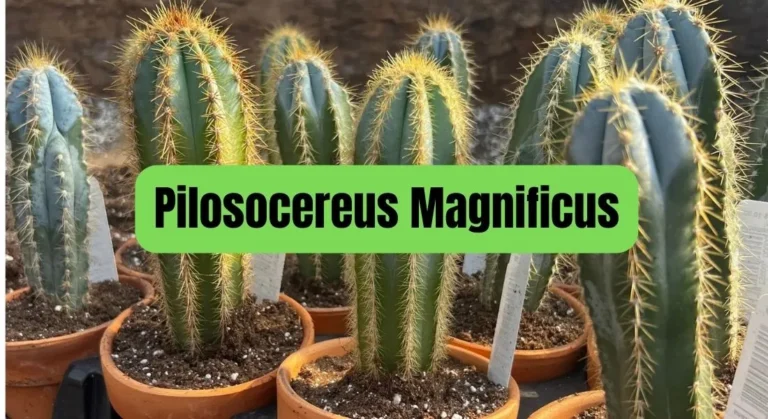Unraveling the Best: Pilosocereus Pachycladus Vs Azureus Cacti
Looking to expand your cactus collection? Consider adding Pilosocereus Pachycladus and Pilosocereus Azureus. These columnar, treelike cacti are known for their unique appearance and easy care.
Pilosocereus Pachycladus can reach up to 10 feet in height with golden spines, while Pilosocereus Azureus typically grows to 6 feet with brownish spines. Both require plenty of direct sunlight, well-draining soil, and can be propagated from stem cuttings or seeds. Keep an eye out for pests and root rot for healthy cacti
Key Takeaways
- Pilosocereus Pachycladus and Pilosocereus Azureus are two unique cacti to consider for your collection.
- These cacti have some differences in height and spine length, but they share similar cultivation and maintenance needs.
- To keep your Pilosocereus cacti healthy, provide them with plenty of sunlight, well-draining soil, and address any common issues promptly.

Pilosocereus Pachycladus vs Azureus
If you’re looking for a cactus to add to your collection, you might be considering Pilosocereus Pachycladus and Azureus Cacti.
While both of these cacti are unique and beautiful, they have some distinct differences in their appearance, growth, and care requirements. In this section, we’ll explore the characteristics of each cactus and compare their growth and care requirements.
Characteristics Of Pilosocereus Pachycladus
Pilosocereus Pachycladus is a columnar cactus that can grow up to 10 feet tall. Its stems are green with brownish spots and have long, golden spines.
This cactus is also known for its beautiful flowers, which are white and bloom at night. Pilosocereus Pachycladus is a slow-growing cactus and can take several years to reach its full height.
Characteristics Of Azureus Cacti
Azureus Cacti, also known as Pilosocereus Azureus, is a blue cactus with shorter, brownish spines.
This cactus can grow up to 6 feet tall and has a more compact shape than Pilosocereus Pachycladus. Azureus Cacti is also known for its beautiful flowers, which are pink and bloom at night.
Comparing Growth And Care Requirements
When it comes to growth and care requirements, both Pilosocereus Pachycladus and Azureus Cacti have some similarities. Here are some key points to consider:
- Light: Both cacti require bright, direct sunlight for at least 10-12 hours a day.
- Soil: Both cacti require a well-draining soil and should be planted in a pot with drainage holes.
- Water: Both cacti are drought-tolerant and should only be watered when the soil is completely dry. Overwatering can lead to root rot.
- Temperature: Both cacti prefer warm temperatures between 60-90°F (15-32°C).
- Fertilizer: Both cacti can benefit from a balanced fertilizer during the growing season.
However, there are some differences in their growth and care requirements:
- Size: Pilosocereus Pachycladus can grow taller than Azureus Cacti, so it may require a larger pot and more space to grow.
- Spines: Pilosocereus Pachycladus has longer spines than Azureus Cacti, so it may require more caution when handling.
- Color: Azureus Cacti is known for its blue color, which can become more vibrant with more sun exposure. Pilosocereus Pachycladus, on the other hand, has a green stem with brownish spots.
Cultivation And Maintenance
Growing and caring for Pilosocereus pachycladus and Pilosocereus azureus is relatively easy, even for beginner gardeners. In this section, we’ll cover the basics of watering and feeding, light and temperature, and pruning and potting.
Watering And Feeding
Cacti are known for their ability to store water, so it’s important not to overwater them. During the growing season, water your Pilosocereus cacti once a week, allowing the soil to dry out completely between waterings. In the winter, reduce watering to once a month.
When it comes to feeding, use a balanced cactus fertilizer once a month during the growing season. Be sure to follow the instructions on the label and dilute the fertilizer to half strength.
Light And Temperature
Pilosocereus cacti thrive in bright, indirect light. Place them near a sunny window or outside in a spot that gets partial shade.
In terms of temperature, Pilosocereus cacti prefer warm temperatures between 60-80°F (15-27°C). They can tolerate cooler temperatures, but avoid exposing them to frost or freezing temperatures.
Pruning And Potting
Pilosocereus cacti don’t require much pruning, but you can remove any dead or damaged branches with a clean, sharp pair of pruning shears.
When it comes to potting, use a well-draining cactus potting mix and a pot with drainage holes. Repot your Pilosocereus cacti every 2-3 years, or when the plant outgrows its current pot.
Overall, with the right care and attention, your Pilosocereus pachycladus and Pilosocereus azureus cacti will thrive and add a unique touch to your garden or indoor space.
Propagation Techniques
If you’re looking to propagate your Pilosocereus cacti, you have a few options to choose from. In this section, we’ll go over the three most common propagation techniques: seeds, cuttings, and grafting.
Seeds
Growing Pilosocereus from seed is a great option if you’re patient and don’t mind waiting a few years for your cactus to mature. To get started, you’ll need to purchase Pilosocereus seeds from a reputable supplier. Once you have your seeds, follow these steps:
- Fill a small pot with well-draining cactus soil.
- Moisten the soil and let it drain.
- Sprinkle the seeds on top of the soil.
- Cover the seeds with a thin layer of soil.
- Place the pot in a warm, bright location.
- Keep the soil moist but not waterlogged.
- Wait for the seeds to germinate, which can take anywhere from a few days to a few weeks.
Once your seedlings have grown a few inches tall, you can transplant them into larger pots or into the ground.
Cuttings
Propagating Pilosocereus from cuttings is a faster option than growing from seed. To take a cutting, follow these steps:
- Choose a healthy, mature stem and use a clean, sharp knife to cut it at a 45-degree angle.
- Let the cutting dry for a few days in a warm, dry location.
- Fill a small pot with well-draining cactus soil.
- Moisten the soil and let it drain.
- Dip the cut end of the stem in rooting hormone.
- Plant the stem in the soil, burying it about an inch deep.
- Place the pot in a warm, bright location.
- Water the cutting sparingly until it has rooted, which can take a few weeks to a few months.
Once your cutting has rooted, you can transplant it into a larger pot or into the ground.
Grafting
Grafting is a more advanced propagation technique that involves combining two different cactus species to create a new plant. To graft Pilosocereus, you’ll need to find a rootstock cactus that is compatible with Pilosocereus. Here’s how to do it:
- Choose a healthy rootstock cactus and a healthy Pilosocereus stem.
- Use a clean, sharp knife to make a clean cut on both the rootstock and the Pilosocereus stem.
- Match up the two cuts so they fit together perfectly.
- Use grafting tape to wrap the two pieces together.
- Place the grafted cactus in a warm, bright location.
- Water the cactus sparingly until it has rooted, which can take a few weeks to a few months.
Grafting can be a tricky process, so it’s best to do your research and practice on less valuable cacti before attempting to graft Pilosocereus.
Common Issues And Solutions
Growing Pilosocereus Pachycladus and Azureus cacti can be a rewarding experience, but like any plant, they can encounter some issues. Here are some common problems you may encounter and solutions to help keep your cacti healthy and thriving.
Pest Problems
Pests can be a nuisance for any plant, and cacti are no exception. Here are some pests that may target your Pilosocereus cacti and how to deal with them:
- Mealybugs: These small, white insects can be found on the stems and leaves of your cactus. They feed on the plant sap and can cause stunted growth and yellowing of the cactus. To get rid of them, wipe them off with a cotton swab dipped in rubbing alcohol.
- Spider Mites: These tiny pests can cause yellowing and webbing on your cactus. You can use insecticidal soap or neem oil to get rid of them.
- Scale Insects: These pests can be identified by their hard, shell-like covering. They can cause yellowing and leaf drop. To get rid of them, use a cotton swab dipped in rubbing alcohol to wipe them off.
Disease Concerns
Cacti are generally hardy plants, but they can still be susceptible to diseases. Here are some common diseases that may affect your Pilosocereus cacti and how to prevent them:
- Root Rot: This fungal disease can be caused by overwatering or poor drainage. To prevent it, make sure your cactus is planted in well-draining soil and only water when the top inch of soil is dry.
- Bacterial Soft Rot: This disease can cause soft, mushy spots on your cactus. To prevent it, avoid overwatering and make sure your cactus is planted in well-draining soil.
- Fungal Spots: These can appear as brown or black spots on your cactus. To prevent them, avoid overhead watering and make sure your cactus has good air circulation.
Environmental Challenges
Cacti are adapted to survive in harsh environments, but they can still be affected by extreme conditions. Here are some environmental challenges that may affect your Pilosocereus cacti and how to mitigate them:
- Sunburn: Cacti can get sunburned if they are suddenly exposed to too much sunlight. To prevent it, gradually introduce your cactus to more sunlight over time.
- Freezing Temperatures: Pilosocereus cacti are not frost-tolerant and can be damaged or killed by freezing temperatures. To protect your cactus, make sure to bring it indoors or cover it during the winter months.
- Overheating: Cacti can also be damaged by extreme heat. To prevent it, make sure your cactus is planted in a spot with good air circulation and provide some shade during the hottest parts of the day.
By being aware of these common issues and taking steps to prevent or address them, you can help keep your Pilosocereus cacti healthy and thriving.
Similarities Between Pilosocereus Pachycladus and Azureus
- Habitat: Both species are native to Brazil and thrive in hot, dry conditions.
- Color: Both species have a distinctive blue-green color that is caused by a waxy coating on the skin of the cactus.
- Care: Both species require similar care, including well-draining soil, bright light, and infrequent watering.
While there are some differences between Pilosocereus pachycladus and Pilosocereus azureus, both are beautiful and unique cacti that can make a great addition to any collection. Whether you prefer the branching habit of Pilosocereus pachycladus or the striking blue color of Pilosocereus azureus, both of these cacti are sure to impress.
Personally, I have found that Pilosocereus pachycladus is a bit easier to care for than Pilosocereus azureus. The longer spines on Pilosocereus pachycladus make it easier to handle, and the branching habit makes it a bit more forgiving if you accidentally overwater it. However, both of these cacti are relatively easy to care for and can be a great addition to any collection.
Growing and Care
Are you interested in growing and caring for Pilosocereus pachycladus or azureus? These columnar cacti are stunning additions to any garden or indoor space, but they do require some specific care to thrive. In this section, we’ll cover everything you need to know to keep your Pilosocereus healthy and happy.
Pilosocereus Pachycladus Growing and Care
Pilosocereus pachycladus, also known as the blue columnar cactus, is a beautiful plant with blue-green skin and white spines. Here’s what you need to know to grow and care for this stunning cactus:
- Light: Pilosocereus pachycladus loves bright, direct sunlight. Aim for at least 6 hours of direct sunlight per day.
- Water: During the growing season (spring and summer), water your Pilosocereus pachycladus once a week. Allow the soil to dry out completely between waterings. In the winter, cut back on watering to once every two to three weeks.
- Soil: Pilosocereus pachycladus prefers well-draining soil. Use a cactus or succulent potting mix, or make your own by mixing sand, perlite, and potting soil in equal parts.
- Fertilizer: Feed your Pilosocereus pachycladus once a month during the growing season with a cactus fertilizer. Follow the instructions on the label for the best results.
- Temperature: Pilosocereus pachycladus can tolerate temperatures down to 20°F, but it prefers temperatures between 60°F and 80°F.
Azureus Growing and Care
Pilosocereus azureus, also known as the blue torch cactus, is a tall, columnar cactus with blue-green skin and yellow spines. Here’s what you need to know to grow and care for this stunning cactus:
- Light: Pilosocereus azureus loves bright, direct sunlight. Aim for at least 6 hours of direct sunlight per day.
- Water: During the growing season (spring and summer), water your Pilosocereus azureus once a week. Allow the soil to dry out completely between waterings. In the winter, cut back on watering to once every two to three weeks.
- Soil: Pilosocereus azureus prefers well-draining soil. Use a cactus or succulent potting mix, or make your own by mixing sand, perlite, and potting soil in equal parts.
- Fertilizer: Feed your Pilosocereus azureus once a month during the growing season with a cactus fertilizer. Follow the instructions on the label for the best results.
- Temperature: Pilosocereus azureus can tolerate temperatures down to 20°F, but it prefers temperatures between 60°F and 80°F.
Frequently Asked Questions (FAQs)
If you’re new to the world of Pilosocereus cacti, you may be wondering about the differences between Pilosocereus pachycladus and Pilosocereus azureus. Here are some frequently asked questions about these two popular varieties.
Is Pilosocereus Azureus psychoactive?
No, Pilosocereus Azureus is not psychoactive. It does not contain any hallucinogenic compounds like mescaline, which is found in some other cactus species.
Where can I buy Pilosocereus Azureus?
Pilosocereus Azureus is a popular cactus among collectors, and it can be found at many plant nurseries and online stores. You can also check with local cactus and succulent societies to see if they have any for sale or trade.
What is the difference between Pilosocereus pachycladus and Pilosocereus azureus?
Pilosocereus pachycladus and Pilosocereus azureus are two different species of cacti, but they are often confused for one another due to their similar appearance. The main difference between the two is that Pilosocereus pachycladus has thicker stems and spines, while Pilosocereus azureus has thinner stems and spines. Additionally, Pilosocereus azureus is known for its blue-green color, while Pilosocereus pachycladus tends to be more green.
Are Pilosocereus pachycladus and Pilosocereus azureus safe for pets?
Both varieties of Pilosocereus cacti are non-toxic to pets, but they do have spines that can be dangerous if ingested or stepped on. Keep your cacti out of reach of curious pets, and consider using a barrier (such as rocks or a fence) to prevent pets from accidentally coming into contact with them.
Conclusion
In the world of cacti, Pilosocereus pachycladus and Pilosocereus azureus are true showstoppers that can add a touch of magic to any space. From their mesmerizing blue-green skin to their towering columnar shape, these cacti are truly a sight to behold.
But what sets them apart? Which one will you choose to add to your collection? With their unique differences in color, areoles, and care requirements, the choice is ultimately yours. So why not try both? Expand your collection and let these beautiful cacti thrive in your home or garden.





